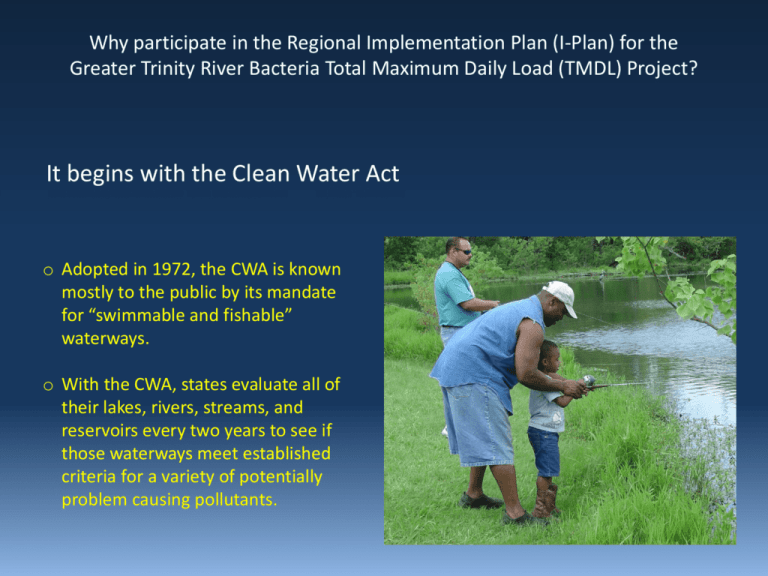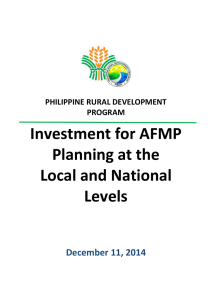Slide 1 - Nctcog
advertisement

Why participate in the Regional Implementation Plan (I-Plan) for the Greater Trinity River Bacteria Total Maximum Daily Load (TMDL) Project? It begins with the Clean Water Act o Adopted in 1972, the CWA is known mostly to the public by its mandate for “swimmable and fishable” waterways. o With the CWA, states evaluate all of their lakes, rivers, streams, and reservoirs every two years to see if those waterways meet established criteria for a variety of potentially problem causing pollutants. o In 1996, the state realized the Upper Trinity and Lower West Fork Trinity Rivers were impaired for bacteria; meaning bacteria levels were too high for people in direct contact with the water (swimmers, water skiers, waders). o In 2006, 13 tributaries joined the Upper Trinity and West Fork on the list of waterways with too much bacteria. Eleven tributaries stem off of the Lower West Fork Trinity; two others are tributaries of the Elm Fork Trinity. We are not alone in this effort Bacteria? Is this our problem? o The sources of high bacteria are many: wildlife, pets, livestock, sanitary sewer overflows, malfunctioning septic systems, urban stormwater runoff, permitted discharges from water treatment plants, and illicit discharges. o When the bacteria levels are too high, stakeholders in the watershed come together to develop an Implementation Plan (I-Plan) to address the problem. o This is not just for those directly along the river or creek – water in a river is the sum of those creeks flowing into it, so a watershed approach is needed. o The area covered by the watersheds of our impaired river segments and tributaries required a regional approach to the bacteria problem. Working as a Region o In late 2010, the Texas Commission on Environmental Quality asked the North Central Texas Council of Governments to bring together all the cities and other stakeholders in impacted watersheds to begin to address the bacteria in the waterways in the form of an I-Plan. o At the heart of this I-Plan are the implementation strategies appropriate for reducing bacteria levels in our region. From 2011 to 2012, this city participated in numerous meetings and discussions hosted by NCTCOG to determine the best possible – and most flexible strategies to deal with bacteria from a variety of possible sources. o Many of the strategies are things we are already doing as part of our TCEQ-required MS4 stormwater permit. Those strategies proposed in the I-Plan that not in our permit are voluntary and may be selected by our community on a menu-style basis. Implementation Strategy Examples Wastewater & • Sanitary sewer overflow prevention, effluent monitoring Stormwater • Regional stormwater management program participation Planning & Development • Green infrastructure and low impact development standards & Animals • Pet and livestock waste control measures More examples Onsite Sewage Facilities & Monitoring Coordination Education & Outreach & Best Management Practices Library • Septic system education for homeowners and real estate agents • Evaluating water testing results to see if Best Management Practices are working • Bacteria-specific outreach and adding information about bacteria to existing education materials • Online BMP Library for stakeholders with information on the topics above Where are we now? o The I-Plan, formally referred to as the, “Implementation Plan for Seventeen Total Maximum Daily Loads for Bacteria in the Greater Trinity River Region,” has now been reviewed at two levels. Locally by the stakeholders who helped create it and by the TCEQ. o In July, the I-Plan will go out for public comment and should be approved by TCEQ’s Commissioners by the end of the calendar year. o The Commissioners would like to see that the stakeholders who helped create this I-Plan also support it and would like a letter of support or resolution from our city. Why support the I-Plan? The city has been an active participant in this voluntary regional initiative. We’ve helped make it a very flexible tool that will enable us to ‘do the right thing’ by doing the things we already do. We can expand if we want, or not, but this partnered effort enables us to take advantage of the experiences of the other stakeholders to have the best water quality programs possible – within budget. The Trinity River has the potential to be a tremendous draw to the region, meaning more visitors, who will stay longer and take advantage of all the region has to offer.







